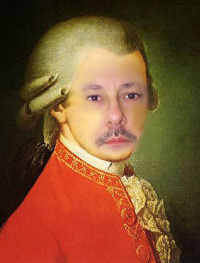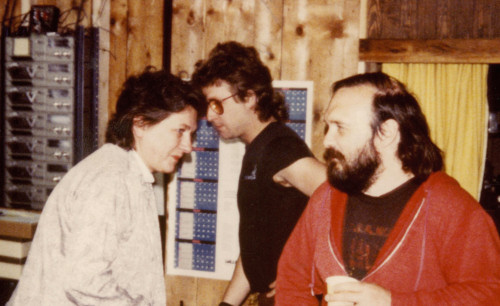A 365-Day Project
"We Are All Mozart"
A project to create
new works and change
the perception of the
music of our time.


 January 26, 2008
January 26, 2008 
It's been a busy day here, doing paperwork cleanup. I keep my finances in the old fruit crate, and sort once a year. Sorting time has arrived, so I'm boring and it's best to jump right to the last of the "We Are All Mozart" compositions
Christopher Smith is a bass trombonist from Montréal, and he wanted not only a flute-piano duet for his kids, but also a bass trombone solo. The instrument has such a wonderful sound and a marvelous range, and I've had a fondness for the slightly nasal and narrow sound whose dynamics can whisper, rock or blast. The composition, Curious Crimson Glow is an intense fantasy for the instrument and the player's voice. It moves is swooping argeggios, slow and fast slides, and vocal multiphonics. Yes, it whispers, rocks and blasts -- and is a refreshing compositional shift after so many pieces for piano, strings, and winds, and no brass for five weeks. Here is the score; there's no demo of this complicated piece (the curious crimson glow is, of course, the player's lips).
Eleanor Fisher was a remarkable woman. She and her husband Ed, a minister, ran a print shop in Storrs, Connecticut, had ten children, and moved to Vermont several decades ago ... to a house far into the hills, without power or telephone. He was incredibly studied, a brilliant thinker and polyglot, and Ellie was every bit his match. She kept him and the children even and balanced, and together they worked to put all ten through college. Ed married Stevie and me, and sang bass in the choir I directed for several years. Ellie didn't sing, but loved music. We first met when she came to my door in Roxbury, Vermont, where my small computer business was looking for a secretary. Ellie had the qualifications on a typewriter, but adapted to computer technology in quite literally one day -- plus she was marvelously funny and ironic. The six of us in the company had wonderful times until its demise in 1986. Ellie went on to write the local Historical Society newspaper, living happily in a home finally with phone and electricity. Ed died a few years ago, and Ellie unexpectedly died in September, after she had commissioned a piano piece. In thinking about her music loves, I recalled her favorite hymn, Eternal Father, Strong to Save, and so created a brief piano prelude on the hymn. Here is the score of Strong to Save and here is a demo.
Jumping in toward the end of the project was brilliant composer Alex Shapiro, whose CD was featured in these commentaries in October. Alex wanted a kind of collaboration -- I was to write her a single minute's worth of music, just one line, and she would take it from there. We'll see what happens, but for now, here is the score to Incanta and a little demo.
Then came December 29. I had accepted a commission from the Living Room Foundation in memory of Randy Hostetler. The front page of this score to 99 Events for the Found, the Made, and the Natural in Memory of Randy Hostetler explains it all:
|
This is a collection of performance events, ranging from the purely musical through the conceptual. Pianist and performance artist Randy Hostetler left a legacy of imagination and truth, and this collection attempts to consider how continuing the performance art experiment may be a reminder of that imagination. There are thirteen types of events created for this collection, regarding balls, electro-mechanical devices, animals, wind, general participation, long-term occurrences, nature, fire, distances, bodies, kitchens, crowds, voices, and miscellany. They are repetitive events, sequential events, chance events, and coerced events; all can be documented and reused to build new events or combinatorial events. Each is informed by my life here in rural Vermont, where time can be taken to explore the long-term, the quiet, and the awkward. Fifty years ago when performance art was born, it was both urban and confrontational by its very existence. Taking a new approach to sources and their presentation was confounding and infuriating to audiences, and resisted by traditional artists and performers. In the times since, performance art has shown its meaning as a river of new ideas that re-invigorate music and the associated arts--but it remains both confrontational and confounding. Those who feel it is frivolous will not be convinced by it; those who are always in search of a sideways view or who reject functional fixedness will be intrigued. Some of these performance events are nearly imaginary, where the likelihood of performance is so small that they are conceptual at best. Some seem wasteful, intrusive, or empty of emotion. Others bring more meaning to their organization and preparation than the resulting event itself. Most are open-ended and leave the responsibility on the performers to create art from instructions. So for each event--even should it seem tongue-in-cheek--a commitment is required. It may cost time or money, or cast the performer in a frivolous light to colleagues and friends. Though some of the events themselves may be light, their presentation cannot be taken lightly because they may involve dangers or expense or even cost to career. Some may be illegal and physically dangerous. At this time in artistic history, the disclaimers above may seem necessary. When the Fluxus artists first commandeered their audiences with mysterious and confusing events, society was more innocent and less litigious. One could dive into the first row without fear. And so, dive into these events. The numbers are simply a random organization of events determined by shaking them up in a paper bag. Pick a few, organize them, refine them, and expand the consideration of sound and space and the act of performance itself. Document them. Rework them. Create new events from the detritus of the old. Creation and performance are the acts of birth and rebirth, of the imagination and the concrete, of darkness and light. |
Creating ninety-nine events in a single day was blindingly exhausting. I fell into bed minutes after finishing them. The events are different and fun, so grab the score and try some.
The next day came a piece for Jeremiah Reilly. He wanted a little duet for cello and guitar -- tonal, melodic, he said, something as a gift for friends. Cello was popular during WAAM, and so my chops had gotten better writing for it. Two melodies and arpeggios -- yes, tonal and melodic. Grab the score to To the Secretary of Good Fortune and listen to this demo.
The end of the year was upon us. Noah Creshevsky had begun it and ended it with bookends of electronic pieces. The first was back on January 1, Graffiti: A New Year's Celebration for Noah., based on his voice. For year's end, it would be electronic as well, and again based on voices -- mine. The text was from the Song of Solomon (5:1-6), in Latin, a language Noah loves to use in his own work. There are six different explorations of the six verses woven in time and space, and from the middle onward, five words rise from the threaded text: suum, meam, suum, fructum and rore (yours, mine, yours, fruit, dew). The sixth word is unspoken. Time and date (18 months, 3 weeks, 3 days, 6 verses, 6 versions, 6 words) are all in threes. This is Voices in My Night.
But that's only ninety-nine compositions. What happened to the one hundredth? What happened was brain freeze on a piece due on November 22. It was to be composed as a recursive conversation among instrumentalists -- string quartet, wind quartet and piano. A nightmare. The piece was complicated because of the recursiveness: each element of the original material had to fold in on itself. It begins as a kind of stretto, and the pace increases. Every fragment from then on is a chip of that original, transformed, placed elsewhere, curling around again and again. The repetitions are always present, but disguised by the pattern of the original, sections nesting inside themselves. It was written in a kind of delirium, I confess, after having germinated for weeks, being completed at 10:24 on New Year's Eve. Here is the score to Horizon (Ocean) and here is a demo. Oh. Who commissioned it? My wife Stevie, in one of her great moments of revelation in conceptualizing how music might be invented outside the normal sonata-box.
And so that was my year. It will turn into a book sometime this fall or winter.
* * *

Ellie Fisher at Green Mountain Micro in the early 1980s, along with Dave DeFelice and Steve Lusk.